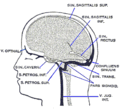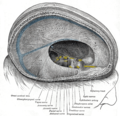Straight sinus
Straight sinus
The straight sinus (Latin: sinus rectus) is an area of the dura mater, the outermost layer of the meninges, the membranes surrounding the brain and spinal cord. It is a dural venous sinus, a channel that carries blood from the brain back to the heart.
Anatomy[edit]
The straight sinus is located at the junction of the falx cerebri, a sickle-shaped fold of the dura mater that separates the two cerebral hemispheres, and the tentorium cerebelli, a horizontal fold of the dura mater that separates the cerebrum from the cerebellum. It runs in a posterior direction from the confluence of sinuses to the transverse sinuses.
Function[edit]
The straight sinus receives blood from the inferior sagittal sinus, which runs along the inferior edge of the falx cerebri, and the great cerebral vein, which drains blood from the inner areas of the brain. It then drains into the left transverse sinus.
Clinical significance[edit]
Due to its location, the straight sinus is relatively protected from injury. However, it can be involved in certain medical conditions. Thrombosis, or blood clot formation, in the straight sinus can lead to cerebral venous sinus thrombosis, a type of stroke. This is a rare condition, but can be life-threatening.
See also[edit]
References[edit]
<references />
-
Straight sinus - anatomical illustration
-
Straight sinus - sagittal section
-
Straight sinus - transverse section
-
Straight sinus - MRI scan
Ad. Transform your life with W8MD's Budget GLP-1 injections from $75


W8MD offers a medical weight loss program to lose weight in Philadelphia. Our physician-supervised medical weight loss provides:
- Weight loss injections in NYC (generic and brand names):
- Zepbound / Mounjaro, Wegovy / Ozempic, Saxenda
- Most insurances accepted or discounted self-pay rates. We will obtain insurance prior authorizations if needed.
- Generic GLP1 weight loss injections from $75 for the starting dose.
- Also offer prescription weight loss medications including Phentermine, Qsymia, Diethylpropion, Contrave etc.
NYC weight loss doctor appointmentsNYC weight loss doctor appointments
Start your NYC weight loss journey today at our NYC medical weight loss and Philadelphia medical weight loss clinics.
- Call 718-946-5500 to lose weight in NYC or for medical weight loss in Philadelphia 215-676-2334.
- Tags:NYC medical weight loss, Philadelphia lose weight Zepbound NYC, Budget GLP1 weight loss injections, Wegovy Philadelphia, Wegovy NYC, Philadelphia medical weight loss, Brookly weight loss and Wegovy NYC
|
WikiMD's Wellness Encyclopedia |
| Let Food Be Thy Medicine Medicine Thy Food - Hippocrates |
Medical Disclaimer: WikiMD is not a substitute for professional medical advice. The information on WikiMD is provided as an information resource only, may be incorrect, outdated or misleading, and is not to be used or relied on for any diagnostic or treatment purposes. Please consult your health care provider before making any healthcare decisions or for guidance about a specific medical condition. WikiMD expressly disclaims responsibility, and shall have no liability, for any damages, loss, injury, or liability whatsoever suffered as a result of your reliance on the information contained in this site. By visiting this site you agree to the foregoing terms and conditions, which may from time to time be changed or supplemented by WikiMD. If you do not agree to the foregoing terms and conditions, you should not enter or use this site. See full disclaimer.
Credits:Most images are courtesy of Wikimedia commons, and templates, categories Wikipedia, licensed under CC BY SA or similar.
Translate this page: - East Asian
中文,
日本,
한국어,
South Asian
हिन्दी,
தமிழ்,
తెలుగు,
Urdu,
ಕನ್ನಡ,
Southeast Asian
Indonesian,
Vietnamese,
Thai,
မြန်မာဘာသာ,
বাংলা
European
español,
Deutsch,
français,
Greek,
português do Brasil,
polski,
română,
русский,
Nederlands,
norsk,
svenska,
suomi,
Italian
Middle Eastern & African
عربى,
Turkish,
Persian,
Hebrew,
Afrikaans,
isiZulu,
Kiswahili,
Other
Bulgarian,
Hungarian,
Czech,
Swedish,
മലയാളം,
मराठी,
ਪੰਜਾਬੀ,
ગુજરાતી,
Portuguese,
Ukrainian




